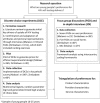'I will choose when to test, where I want to test': investigating young people's preferences for HIV self-testing in Malawi and Zimbabwe
- PMID: 28665878
- PMCID: PMC5497773
- DOI: 10.1097/QAD.0000000000001516
'I will choose when to test, where I want to test': investigating young people's preferences for HIV self-testing in Malawi and Zimbabwe
Abstract
Objectives: The current study identifies young people's preferences for HIV self-testing (HIVST) delivery, determines the relative strength of preferences and explores underlying behaviors and perceptions to inform youth-friendly services in southern Africa.
Design: A mixed methods design was adopted in Malawi and Zimbabwe and includes focus group discussions, in-depth interviews and discrete choice experiments.
Methods: The current study was conducted during the formative phase of cluster-randomized trials of oral-fluid HIVST distribution. Young people aged 16-25 years were purposively selected for in-depth interviews (n = 15) in Malawi and 12 focus group discussions (n = 107) across countries. Representative samples of young people in both countries (n = 341) were administered discrete choice experiments on HIVST delivery, with data analyzed to estimate relative preferences. The qualitative results provided additional depth and were triangulated with the quantitative findings.
Results: There was strong concordance across methods and countries based on the three triangulation parameters: product, provider and service characteristics. HIVST was highly accepted by young people, if provided at no or very low cost. Young people expressed mixed views on oral-fluid tests, weighing perceived benefits with accuracy concerns. There was an expressed lack of trust in health providers and preference for lay community distributors. HIVST addressed youth-specific barriers to standard HIV testing, with home-based distribution considered convenient. Issues of autonomy, control, respect and confidentiality emerged as key qualitative themes.
Conclusion: HIVST services can be optimized to reach young people if products are provided through home-based distribution and at low prices, with respect for them as autonomous individuals.
Similar articles
-
When healthcare providers are supportive, 'I'd rather not test alone': Exploring uptake and acceptability of HIV self-testing for youth in Zimbabwe - A mixed method study.J Int AIDS Soc. 2021 Sep;24(9):e25815. doi: 10.1002/jia2.25815. J Int AIDS Soc. 2021. PMID: 34569710 Free PMC article. Clinical Trial.
-
Youth-friendly HIV self-testing: Acceptability of campus-based oral HIV self-testing among young adult students in Zimbabwe.PLoS One. 2021 Jun 29;16(6):e0253745. doi: 10.1371/journal.pone.0253745. eCollection 2021. PLoS One. 2021. PMID: 34185815 Free PMC article. Clinical Trial.
-
HIV self-testing: breaking the barriers to uptake of testing among men and adolescents in sub-Saharan Africa, experiences from STAR demonstration projects in Malawi, Zambia and Zimbabwe.J Int AIDS Soc. 2019 Mar;22 Suppl 1(Suppl Suppl 1):e25244. doi: 10.1002/jia2.25244. J Int AIDS Soc. 2019. PMID: 30907505 Free PMC article.
-
Acceptability and use of HIV self-testing among young people in sub-Saharan Africa: a mixed methods systematic review.BMC Prim Care. 2024 Oct 15;25(1):369. doi: 10.1186/s12875-024-02612-0. BMC Prim Care. 2024. PMID: 39407123 Free PMC article.
-
A systematic review of qualitative evidence on factors enabling and deterring uptake of HIV self-testing in Africa.BMC Public Health. 2019 Oct 15;19(1):1289. doi: 10.1186/s12889-019-7685-1. BMC Public Health. 2019. PMID: 31615461 Free PMC article.
Cited by
-
Overcoming cultural barriers to implementing oral HIV self-testing with high fidelity among Tanzanian youth.Transl Behav Med. 2021 Feb 11;11(1):87-95. doi: 10.1093/tbm/ibz157. Transl Behav Med. 2021. PMID: 31785201 Free PMC article. Clinical Trial.
-
Understanding factors that promote uptake of HIV self-testing among young people in Nigeria: Framing youth narratives using the PEN-3 cultural model.PLoS One. 2022 Jun 3;17(6):e0268945. doi: 10.1371/journal.pone.0268945. eCollection 2022. PLoS One. 2022. PMID: 35657809 Free PMC article.
-
Sexual behavior experiences and characteristics of male-female partnerships among HIV positive adolescent girls and young women: Qualitative findings from Zimbabwe.PLoS One. 2018 Mar 22;13(3):e0194732. doi: 10.1371/journal.pone.0194732. eCollection 2018. PLoS One. 2018. PMID: 29566062 Free PMC article.
-
Feasibility of an HIV self-testing intervention: a formative qualitative study among individuals, community leaders, and HIV testing experts in northern Tanzania.BMC Public Health. 2020 Apr 15;20(1):490. doi: 10.1186/s12889-020-08651-3. BMC Public Health. 2020. PMID: 32293370 Free PMC article.
-
"But I Gathered My Courage": HIV Self-Testing as a Pathway of Empowerment Among Ugandan Female Sex Workers.Qual Health Res. 2021 Feb;31(3):443-457. doi: 10.1177/1049732320978392. Qual Health Res. 2021. PMID: 33427073 Free PMC article.
References
-
- UNAIDS. AIDS by the numbers. Geneva, Switzerland: Joint United Nations Programme on HIV/AIDS (UNAIDS); 2016. - PubMed
-
- National Statistical Office (NSO); ICF Macro. Malawi Demographic and Health Survey 2010. Zomba, Malawi, and Calverton, Maryland, USA: NSO and ICF Macro; 2011.
-
- Zimbabwe National Statistics Agency; ICF International. Zimbabwe demographic and health survey 2015: final report. Rockville, Maryland, USA: Zimbabwe National Statistics Agency (ZIMSTAT) and ICF International; 2016.
Publication types
MeSH terms
Grants and funding
LinkOut - more resources
Full Text Sources
Other Literature Sources
Medical


